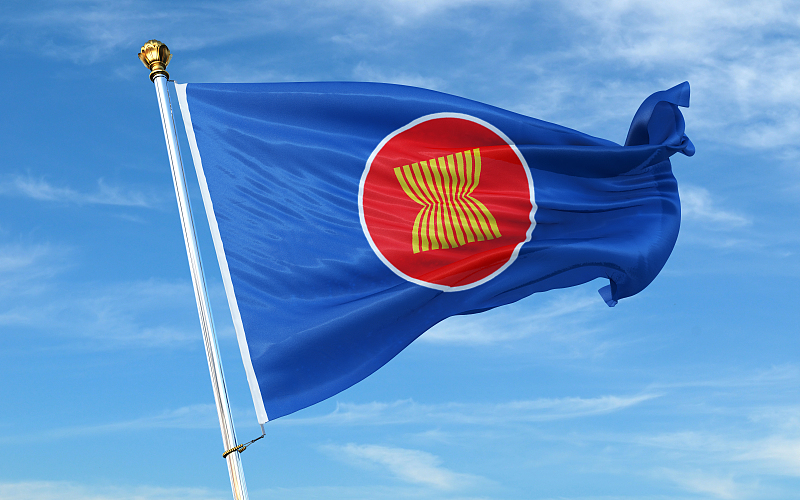
A roadside sign of ASEAN Summit 2023 in Jakarta, Indonesia, May 5, 2023. /Xinhua
A roadside sign of ASEAN Summit 2023 in Jakarta, Indonesia, May 5, 2023. /Xinhua
Editor's note: C. Saratchand is a professor at the Department of Economics, Satyawati College at the University of Delhi in India. The article reflects the author's opinions and not necessarily the views of CGTN.
The Association of Southeast Asian Nations (ASEAN) is holding its 2023 summit in Indonesia on May 10-11. The theme of this ASEAN summit is: ASEAN Matters: Epicentrum of Growth. Three broad thematic goals have been identified at this summit: Firstly, locating ASEAN as a key center of regional and world development; secondly, making ASEAN a fast-growing, inclusive and sustainable economic region in the long term; thirdly, seeking to make the Indo-Pacific a region of peace and prosperity through all-round cooperation.
Some significant initiatives towards the achievement of these thematic goals include discussing the Southeast Asian Nuclear-Weapon-Free Zone Treaty (SEANWFZ), trading with local currencies, enhancing health cooperation, augmenting food and energy security, establishing an ecosystem for electric vehicles, and so on.
Southeast Asia is a key region in the world as far as international politics and economy are concerned, not least because it is the center of world manufacturing along with East Asia. Its location also has meant that the U.S has tried (in vain) to incorporate ASEAN in its ongoing attempts to "contain" China. ASEAN and China are deeply integrated strategically with each other and therefore with the rest of the world. Consequently, the strategic isolation of China is neither feasible nor conducive for global development.
Moreover, ASEAN as an organization and most of its members are in line with the third thematic goal that was previously mentioned, having adopted the rational policy option of strategic autonomy. This has involved maintaining friendly relations with all its partner countries and therefore refusing to be a constituent in this "containment" attempt. Thus for instance, ASEAN has refused to connect itself directly or indirectly with the Australia-United Kingdom-United States (AUKUS) grouping that is a fresh attempt by the U.S. to "contain" China. The SEANWFZ may be seen as an implicit rejection of AUKUS.

Likewise, ASEAN has disassociated itself from any attempt by the U.S. and its allies to become a direct or indirect participant in the conflict in Ukraine. Instead ASEAN has chosen to call for restraint and dialogue to resolve the conflict which is line with most countries in the world. However, the unfolding of the Ukraine conflict and the failure of the economic sanctions against Russia has had important implications for international political economy.
This failure is principally due to the fact that most developing countries (including ASEAN member countries) have refused to be part of it. The refusal stems from the fact they seem to have rightly discerned that U.S. hegemony has relatively declined and this process will continue. This relative decline has encompassed economic, military and technological domains. It has also led to strategic realignments such as the diplomatic rapprochement between Iran and Saudi Arabia, which was facilitated by China, and the recent visit of the French President Emmanuel Macron to China. Therefore ASEAN has chosen to chart its path in this new conjuncture by diversifying its strategic linkages with different parts of the world in line with the three previously mentioned thematic goals.
One key aspect of this planned diversification of ASEAN's strategic linkages with the rest of the world is the use of local currencies for transactions. Moves in this direction emerged due to the unilateral attempt by the U.S. and its allies, in contravention of international law, to confiscate a part of the foreign exchange reserves of Russia that were denominated in U.S. dollars and euros. Currently, three ASEAN member countries, namely Indonesia, Malaysia and Thailand, are working with three other countries — Japan, China and South Korea — on local currency transactions.
However, the quest to attain these three thematic goals has to reckon with the fact that they are dialectically linked. Thus, greater economic integration among ASEAN member countries could enable faster economic growth which in turn would move ASEAN further along the trajectory of becoming the center of regional and world development. Likewise, the cooperation between countries that would need to underlie peace and prosperity in the region could allow for faster economic growth in and greater integration among ASEAN member countries.
ASEAN's quest for strategic autonomy as encapsulated in the three thematic goals of its summit in 2023 will be strengthened if the regional grouping dovetails its efforts with other like-minded organizations such as BRICS, the Shanghai Cooperation Organization, the African Union and so on.
(If you want to contribute and have specific expertise, please contact us at opinions@cgtn.com. Follow @thouse_opinions on Twitter to discover the latest commentaries in the CGTN Opinion Section.)